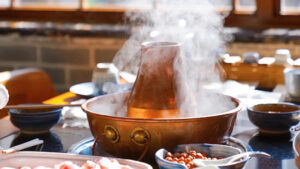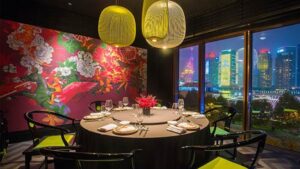Home » Beijing » Beijing Chinese Food
Beijing is the capital of China and one of the top eight cities in the world for food. When you come to Beijing, apart from visiting the city’s famous monuments and experiencing the capital’s profound historical and cultural heritage, please follow this article to enjoy the food in Beijing.
Food in Beijing – Snacks
Among the food in Beijing, the local people are most proud of the Beijing snacks. Beijing’s snacks have a wide variety with a long history. They are made with exquisite ingredients and fine craftsmanship. Beijing snacks mainly originated from the imperial kitchen of the Qing Dynasty(1644—1912). Let’s find out what snacks to eat in Beijing.
. Lv Dagun (Soybean cake)
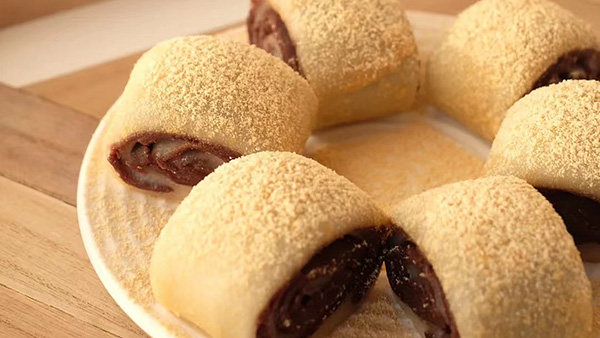
Lv Dagun is made of glutinous rice flour and rolled in soybean flour. Beijingers call it Lv Dagun, which means “Donkey Rollings.” It is sticky and sweet in the mouth and has a light fragrance of cinnamon.
. Wan Dou Huang (Pea cake)
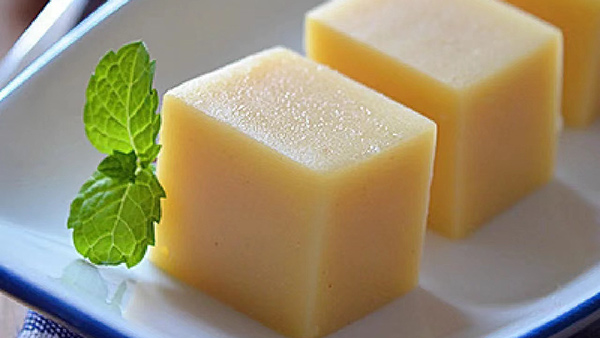
People choose good, full peas when making Pea Cake. The peas are peeled and crushed, boiled in water, fried with cinnamon sugar, and poured into a container to solidify. They are cut into small pieces for eating. The Pea Cake is delicate and sweet, cool and refreshing. The best ones will melt in your mouth.
. Ai Wo Wo (Steamed rice cakes with sweet stuffing)
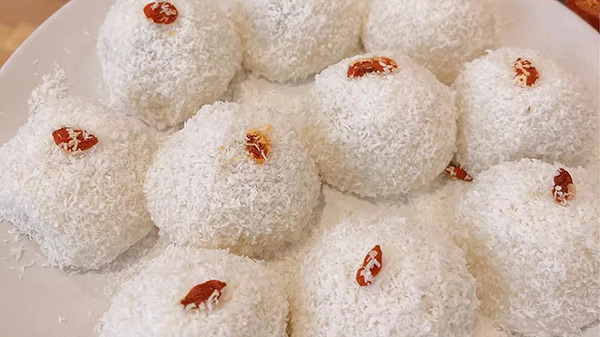
When people make Ai Wo Wo, glutinous rice is steamed and kneaded into a round skin. Then, the glutinous rice skin is filled with walnuts, sesame seeds, melon seeds, plums, golden cake, sugar, and other fillings. The texture of Ai Wo Wo is sticky and soft.
. Tang Hulu (Candied haws)
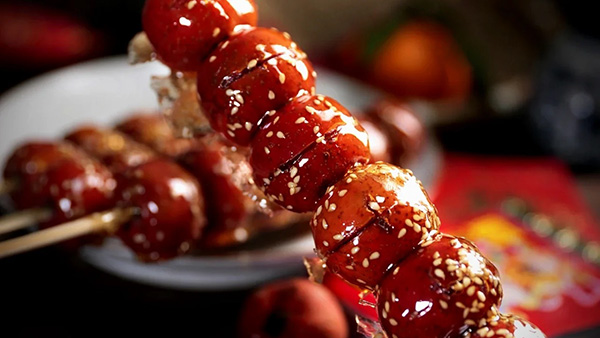
Tang Hulu originated in the Southern Song Dynasty more than 700 years ago. The fruit is skewered on bamboo sticks and dipped in maltose syrup. The maltose syrup rapidly hardened in the wind. It is a common snack in winter in northern China, usually made of hawthorn skewers, and the sugar is frozen hard, so it tastes sour, sweet, and icy. In addition to hawthorn, strawberries, begonia fruit, grapes, hemp yam, and walnuts are also commonly used ingredients.
. Xingren Tofu (Almond Tofu )
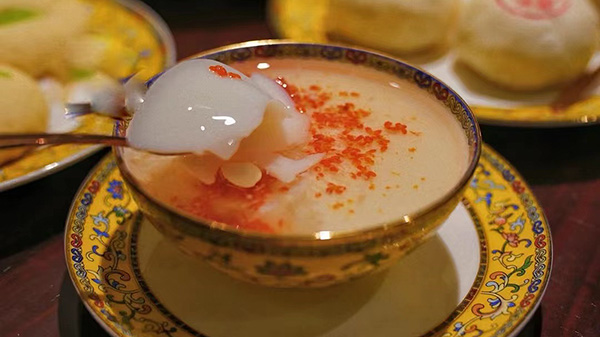
Beijing’s palace Xingren tofu is made from sweet almonds from mountain apricots or flat apricots, which are ground into a pulp and then processed. This snack has a strong almond flavor. It is incredibly fragrant when served with apricot-flavored sugar sauce.
. Yundoujuan (Kidney Bean Rolls)
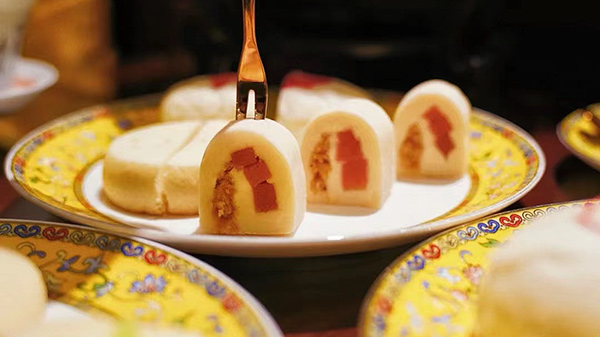
When making kidney bean rolls, large kidney beans are peeled, boiled, and crushed to make a bean paste. After that, the bean pastes are cooled and then rubbed into strips. Finally, the sesame or red bean paste fillings are rolled into the strips. Cut into small pieces for serving. The texture of kidney bean rolls is delicate, and the filling is rich.
. Cha Tang (Seasoned flour mush)
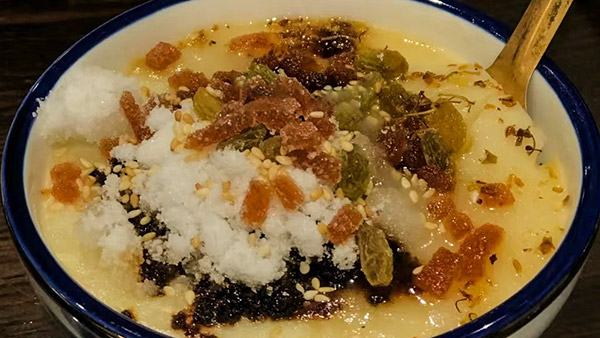
First, mix the almond powder with boiling water to form a paste. Then sprinkle some dried fruits, candied fruits, and green and red shreds inside the almond paste. The colors of the ingredients match beautifully. Eat with a small spoon, full of almond flavor.
. Hama Tumi (Bean paste scone)

In the baking process, because there is a natural opening on the side of the scones, spitting out the bean paste filling is hanging on the side of the scones, so people figuratively call these scones Hama Tumi, which means toad spit honey in Chinese. You’d better have the cake while it is hot. The outside and the overflowing filling are burnt, while the inside is fragrant, which is incredibly delicious.
. Jiangsi Paicha (Fried ginger slices)
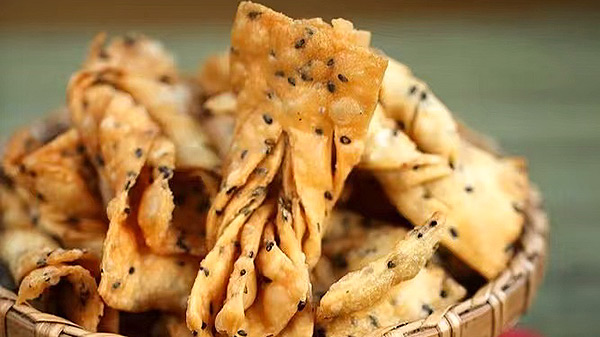
From the name, you can know that one of the raw materials of Fried ginger slices is fresh ginger. Thus it has a distinct fresh ginger flavor when consumed. The finished Fried ginger slices are light yellow in color and have the characteristics of crispy, sweet, and fragrant. It tastes sweet but not greasy, full of ginger flavor, and very unique.
. Tang Erduo (Ear-shaped twists with sugar)

Tang Erduo are a common snack in Beijing, named after their shape, which resembles a human ear. They are brown and oily in color and have a soft and fluffy texture, which makes them sweet and delicious to eat. It is a popular snack among the elderly and children in Beijing.
. Tang Huoshao (Sweetened baked wheaten cake)
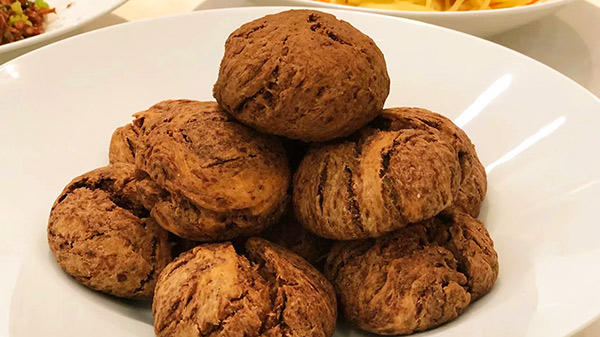
Tang Huoshao is a traditional Beijing snack with a history of over 300 years. Brown sugar, sesame paste, and cinnamon are mixed with flour and fermented. In ancient times, people would use a large vat to make a stove and bake the cake directly on the wall of the vat. Tang Huoshao is one of the most popular breakfast items in Beijing. Its sweet taste, softness, and non-stickiness make it ideal for the elderly.
. Douzhi’er (Fermented mung bean milk)

Douzhi’er is made by fermenting the residue of mung beans. Because mung beans are rich in protein, vitamin C, and crude fiber, Douzhi’er nourishes the stomach, detoxifies the body, and eliminates dryness and heat. Not everyone can accept the taste of it. Because it is made by fermentation, it has a sour smell. Old Beijingers usually drink Douzhi’er with Jiaoquan. A bite of Jiaoquan and a bite of bean juice have a unique taste. Some people, however, avoid it when they smell it. It has a long history and is said to have been popular in Beijing during the Song Dynasty more than 900 years ago. And it was introduced to the palace during the reign of Emperor Qianlong in the Qing Dynasty more than 300 years ago.
. Jiaoquan(Fried ring)
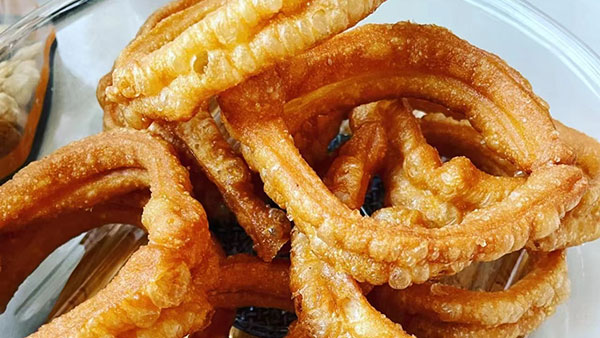
Jiaoquan is an old Beijing traditional snack. It is deep yellow in color, shaped like a bracelet, crispy and unique in flavor. Beijingers love to eat Jiaoquan in the middle of the baklava, and they also love to eat them together with Fermented mung bean milk.
. Baodu (Cooked tripe of sheep or swine)
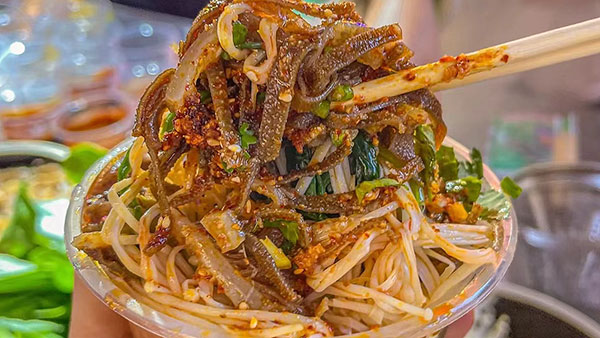
Baodu is fresh beef tripe or lamb tripe washed, cut into strips, and then boiled in boiling water. When serving, dip in seasonings made of sesame sauce, vinegar, chili oil, and scallions. Baodu taste crispy, tender and refreshing.
. Chaogan’er (Stewed liver)
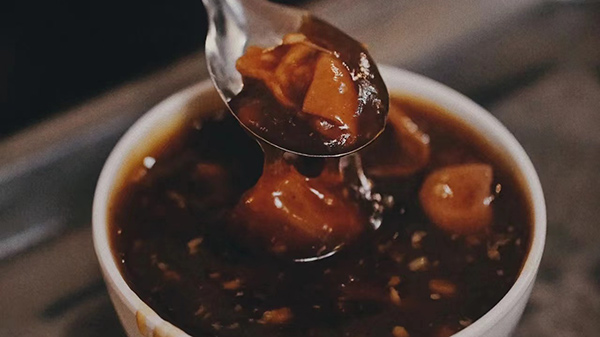
The main ingredients used in Chaogan’er are pork intestine and liver. The seasonings are soy sauce, yellow sauce, raw garlic puree, cooked garlic puree, and pork bone soup. The soup of the finished product is crystal clear, with fatty intestines and tender liver, which is mellow and tasty.
. Luzhu (Bittern flapjack)
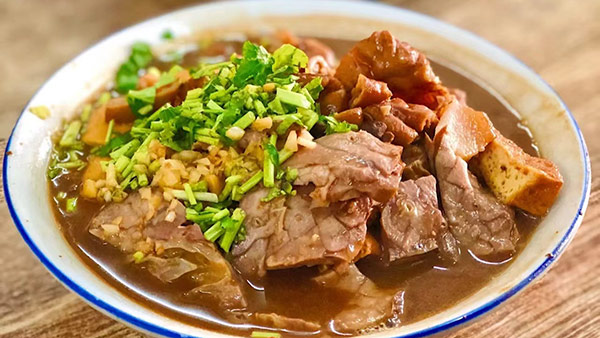
Beijingers began making Luzhu more than 100 years ago, during the Guangxu period of the Qing Dynasty. According to legend, a famous dish, Suzhao Meat, was expensive at that time. To have a gourmet meal, people used pork head meat instead of the pork belly used in making Suzao Meat and cooked it with the same cooking method, adding pork intestines and lungs. This dish has been handed down from generation to generation by master folk cooks and is loved by all.
Beijing Cuisine
Beijing cuisine has a special status in Chinese food culture. It is based on northern Chinese cuisine, and through the fusion of different nationalities, different regions, and unique royal court cuisine, it has slowly formed the present Beijing cuisine culture.
. Peking duck
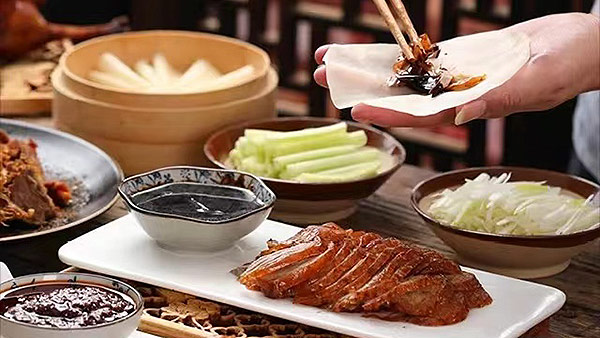
Peking duck began more than 1,500 years ago during the North and South Dynasties, and nowadays, it is famous in China and worldwide and even can be found at national banquets. The Peking duck is roasted over charcoal with high-quality meat, which is red in color, fatty but not greasy, crispy on the outside, and tender on the inside. This dish is respected as “the best dish in the world.”
. Zhajiangmian (The old Beijing Noodles with Soy Bean Paste)
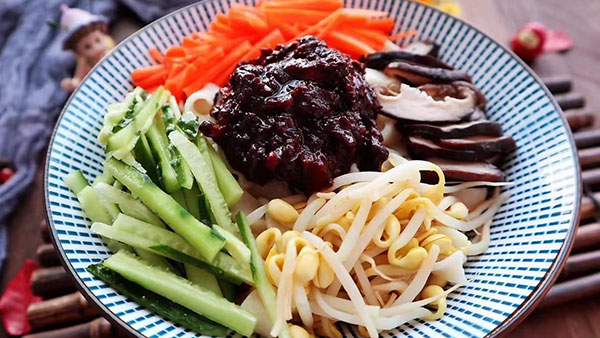
The essence of authentic old Beijing fried noodles is in the fried sauce. First, the chef must melt the good soy bean paste with rice wine. Then, the diced meat, three parts fat and seven parts lean, is slowly fried in the sauce over low heat. This way, the meat sauce will be fragrant and irresistible. At least eight kinds of vegetable ingredients are needed for the dish, including shredded cucumber, green bean sprouts, soybean sprouts, celery, green garlic, shredded radish, shredded cabbage, and garlic. When serving, mix the meat sauce and vegetables with the noodles thoroughly, and it will be beautiful to eat.
. Shuanyangrou (Beijing instant-boiled sliced mutton hotpot)
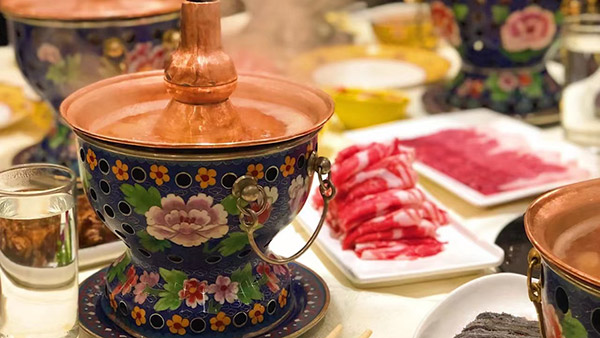
Shuanyangrou is a traditional hot pot popular in Beijing and its surrounding areas. It is so named because the ingredients are mainly mutton. Traditional Shuanyangrou is also about several ingredients other than mutton, such as cabbage, tofu, and vermicelli. In modern times, sliced beef is also an ingredient in Shuanyangrou. The ingredients are placed in a pot of boiling water, cooked, and served with seasonings. This dish is a winter favorite.
. Jingjiang Rousi (Sauteed shredded pork in sweet bean sauce)
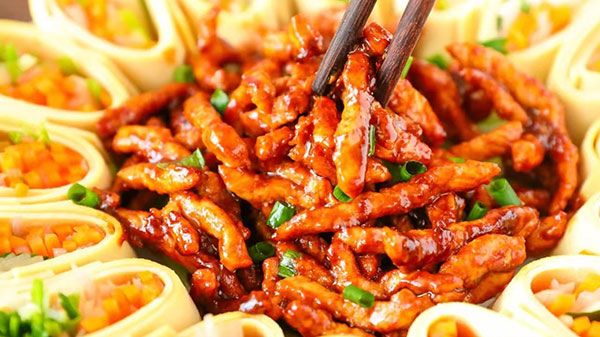
Jingjiang Rousi is one of the classic dishes in Beijing cuisine. It is made with pork tenderloin as the main ingredient, supplemented with sweet sauce, onion, ginger, and other seasonings, and cooked with the unique northern cooking technique of “sauce explosion.” When the dish is ready, it is moderately salty and sweet, with a rich sauce and unique flavor. This dish is not difficult to do, but it is not easy to stir-fry the meat smooth and tender, and shredded meat is wrapped evenly by the sauce. The result is a rich sauce and tender shredded meat.

